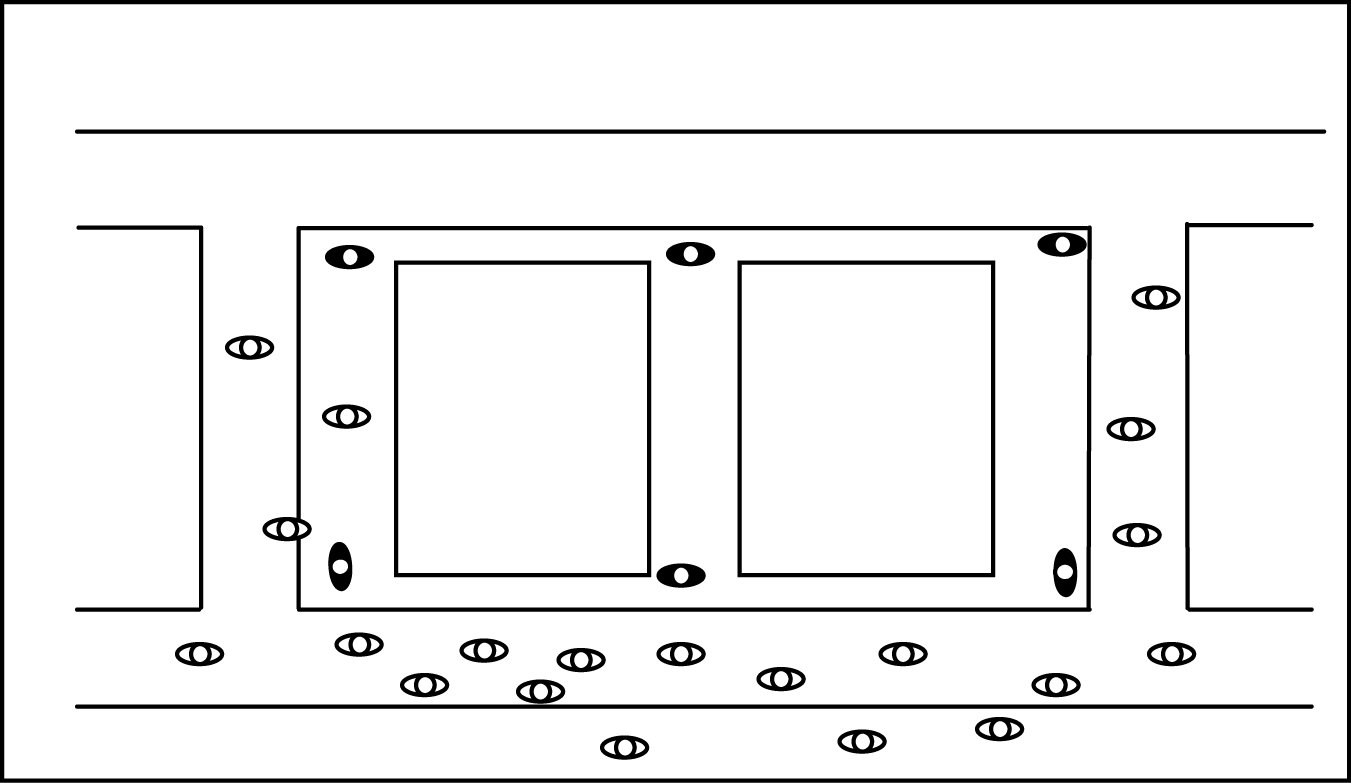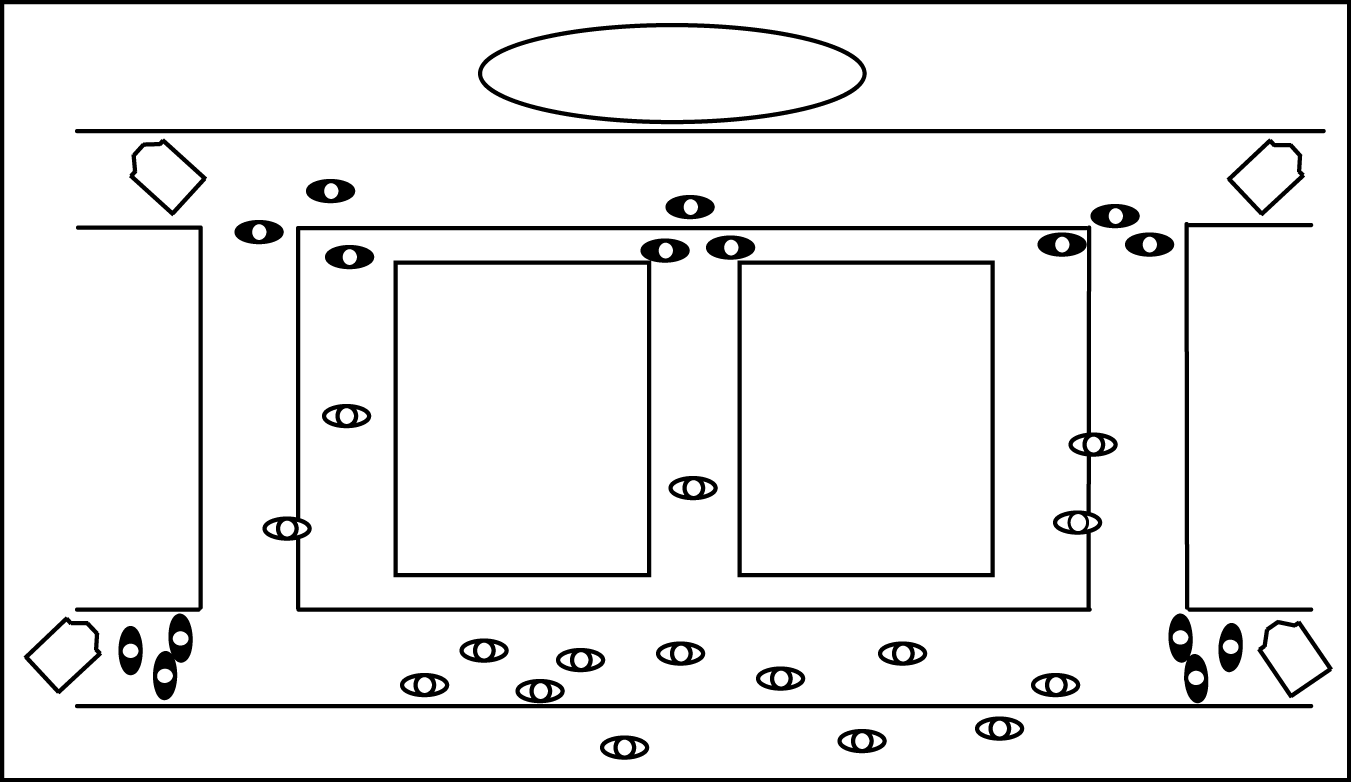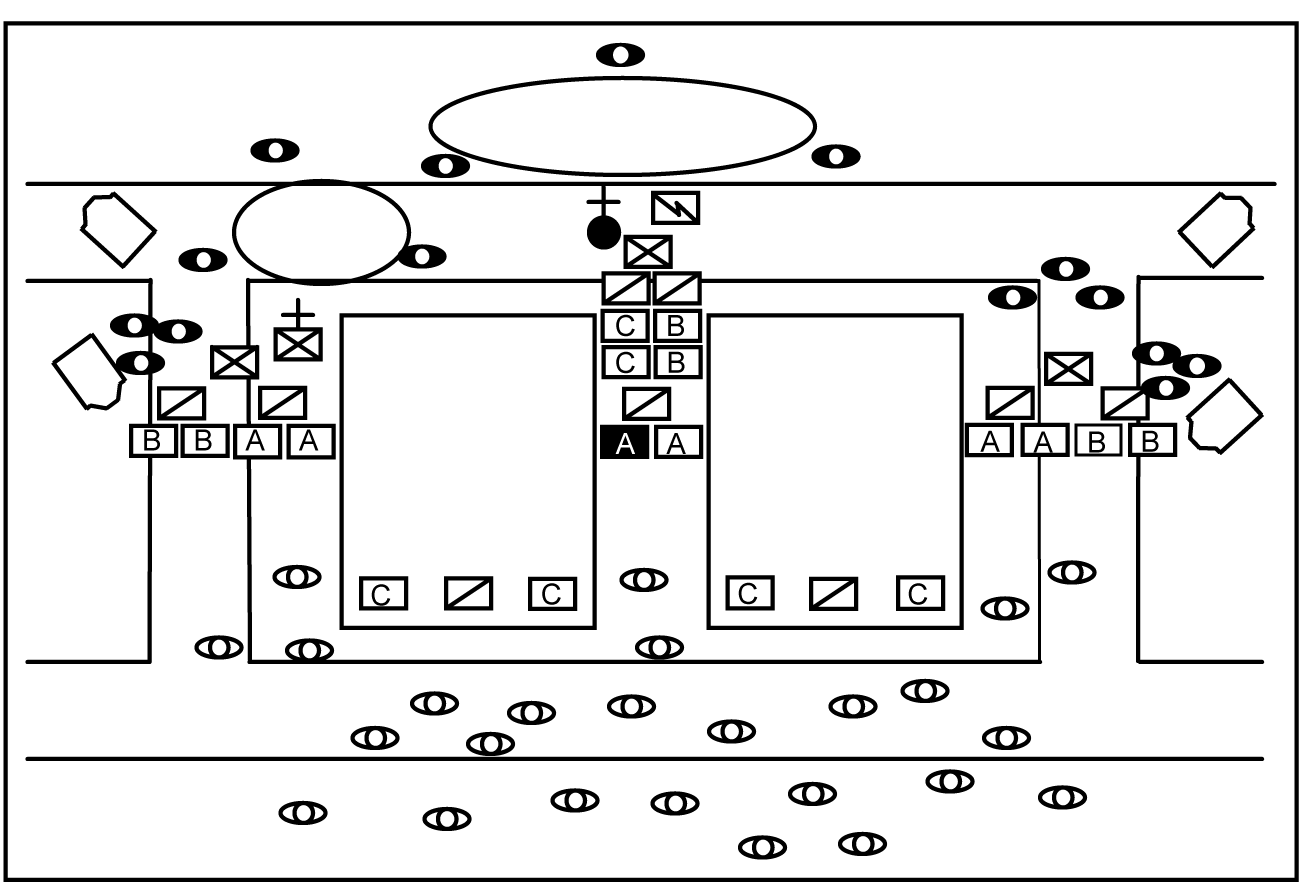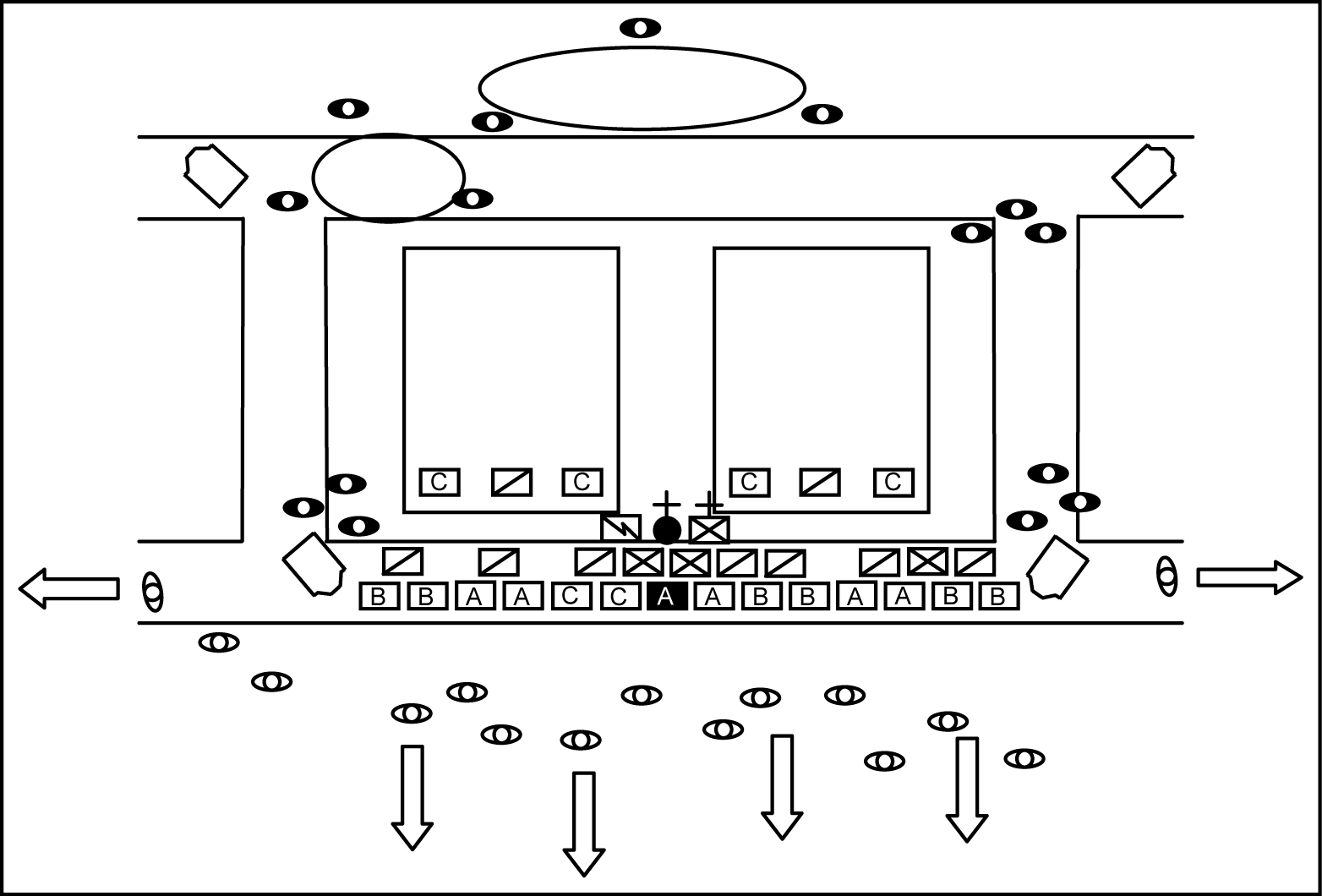Squad Leader
B team member
Team Leader
C team member
Vehicle
Security
Demonstrator
Figure D-1. Symbols for a Formation Element
Orientation
D-8. Crowd dynamics change from people milling around and talking among
themselves in isolated groups to a more collective focus concentrated on a
single objective (for example, TF personnel, specific agitators or magnets, a
government figure, or other activity).
Massing
D-9. The crowd begins to mass or tighten into a large contiguous body from a
loose formation to a static congregation located in a more concentrated area.
Unchecked, massing can provide anonymity and a collective feeling of
invulnerability. This change in group dynamics could provide ideal conditions
for a civil disturbance (see Figure D-2).
D-2
FM 3-19.15
18 April 2005

Practical Application
Building
Building
Figure D-2. Crowd Massing
Chanting
D-10. People may begin chanting slogans or yelling ethnically charged
rhetoric or obscenities. Because chanting can indicate an increase in crowd
intensity, interpreters should be positioned in strategic locations to interpret crowd rhetoric.
Signaling
D-11. Signaling occurs when members of the crowd position themselves to
communicate and synchronize crowd actions tied to a plan with specific
objectives. Signaling may indicate the intent to escalate the message through
the use of violent or unlawful acts.
Blocking
D-12. The crowd may attempt to block public thoroughfares (for example,
entrances and exits to public buildings, MSRs, community streets, or other
traffic areas that may degrade freedom of movement or similar actions). This
escalates the level of attention given to the crowd’s message or prevents
freedom of movement to opposing persons or groups.
Arming
D-13. Any signs that the crowd is arming itself with objects (for example,
bottles, rocks, and sticks) is a clear indication of impending danger to the TF
and other civilians. In fact, during a recent civil disturbance, some members of the crowd were seen handing out bottles to others in the crowd. Arming
demonstrates intent toward violence is unlawful.
18 April 2005
FM 3-19.15
D-3
Practical Application
Outside Influence
D-14. The presence of people from outside the community may indicate more
sophisticated planning and resources than would otherwise be expected from
local community members. Outside people may feel insulated from
responsibility for local actions and, therefore, provide a dangerous catalyst for a violent civil disturbance.
Agitators and Instigators
D-15. Agitators and instigators are common elements associated with civil
disturbances. They often provide a catalyst to incite the crowd toward
violence. Whether spewing rhetoric or committing unlawful acts, their
continued presence will fuel potential strife.
Absence of Children
D-16. Recent civil disturbances have shown that even when children were
initially present at a rally, they were absent before the civil disturbance
erupted with violence. While the presence of children is not a guarantee of a
peaceful assembly, the removal of children from a rally may provide early
warning for a pending escalation of hostilities or a full-blown riot.
PREVENTION OF CROWD ESCALATION
D-17. If TF personnel believe, based on intelligence or negative indicators,
that a crowd is planning to, or may spontaneously, riot they should
immediately engage crowd participants using the preventive TTP measures.
D-18. The force executing these preventive TTP can include a number of civil
disturbance teams and elements capable of executing the tasks shown in
Figures D-2, page D-3; D-3; D-4, page D-6; and D-5, page D-8. These figures demonstrate a full range of crowd control teams and elements, to include
camera teams with interpreters, checkpoints, QRF response, riot control
formation, NLW teams, snatch and detain teams, blocking teams, and
detainee evacuation, as required. Figures D-2, D-3, D-4, and D-5, illustrate the evolution of a crowd formation and the recommended positioning of teams
and elements to engage people as they congregate. Included with each
security team is a designated camera or video recorder.
D-19. Depending on the situation and crowd dynamics, it may not be
necessary to establish all crowd control teams and elements, but they should
be included in planning. Regardless of task organization, teams and elements
must be prepared to execute the crowd control and civil disturbance TTP. The
order to execute the following TTP should be tailored based on local
conditions.
Early Contact
D-20. Engaging people as a crowd forms is essential to prevention. Whether
based on intelligence or negative indicators, people should be engaged early,
before the crowd masses as shown in Figure D-2, rather than waiting until after the crowd masses as shown in Figure D-3. Early contact will assist TFs D-4
FM 3-19.15
18 April 2005

Practical Application
in personalizing their interaction and ensuring that people understand their
presence is known, documented, and can be linked to their actions.
QRF rally point
Building
Building
Figure D-3. Early Contact and Unobtrusive Crowd Control Measures
D-21. Cameras are one of the best tools for preventing civil disturbances. The use of cameras to document crowd formations, particularly lens-size groups
(small enough to fit in a single photo), will personalize contact and eliminate feelings of anonymity among the crowd. People whose identity has been
documented will think twice before committing unlawful acts. Even without
documenting names, photo analysis can identify people associated with the
civil disturbance, especially those who unlawfully participated as crowd
instigators, agitators, or magnets or may commit unlawful acts.
D-22. As people begin to gather in and along streets, camera teams should be
deployed as unobtrusively as possible to engage people before they congregate
in mass. As depicted in Figure D-3, camera teams should consist of two soldiers with an interpreter and be employed in a widely dispersed pattern.
Such small, dispersed camera teams are less likely to intrude on lawful rallies or create invasive friction that might become a catalyst to a civil disturbance.
D-23. As the crowd begins to demonstrate negative indicators for a possible
civil disturbance ( Figure D-4, page D-6), camera teams should become more invasive by actively engaging groups to take their pictures. Camera teams
should focus cameras on instigators, agitators, or magnets (personnel that
garner respect or compliance from the crowd). If a person is purposely
avoiding the camera, even if his activities are lawful, the team should take
special measures to obtain his picture. Each time a camera team takes a
picture of a person or group of people, they must immediately engage them
using the warning outlined in paragraph D-26.
D-24. Once the crowd has massed and displays negative indicators or begins
to riot, camera teams should immediately move behind the riot formation line
18 April 2005
FM 3-19.15
D-5

Practical Application
(see Figure D-4). It is essential, however, that camera teams continue to document the event, focusing on people who are committing illegal acts such
as arming themselves, throwing objects, and assaulting TF personnel.
D-25. Immediately following a crowd control or civil disturbance operation,
photos must be consolidated, processed, and submitted to the TF analysis and
control element (ACE) for analysis. A near real-time analysis will provide
immediate intelligence for ongoing operations to prevent subsequent civil
disturbances or to detain violators from the previous operation.
QRF rally point
Detainee
collection
point
Building
Building
Figure D-4. More Obtrusive Engagement as the Crowd Demonstrates
Negative Indicators
Crowd Warning
D-26. Once the team has taken a picture of a person or group of people, they
should warn the crowd that as individuals they would be held accountable for
their actions. Using an interpreter, the camera team leader will make solid
eye contact with the person or group and state the following warning: “We
have your picture. You will be held accountable for your actions. If you commit an unlawful act, you will be detained, if not today, tomorrow. Blocking roads or access to public buildings is unlawful.”
Limit Crowd Size
D-27. Persons seeking to conduct a rally must apply for a permit through
civilian authorities at least 72 hours prior to the meeting. If a rally has not been lawfully scheduled through civilian authorities, or if it has, but is
demonstrating negative indicators and is turning into a civil disturbance, TF
units and elements should attempt to limit the crowd or separate gatherings
under 10 people (see Figure D-3, page D-5). Walking patrols can assist camera D-6
FM 3-19.15
18 April 2005
Practical Application
teams in breaking up large groups. Walking patrols should operate in
conjunction with camera teams. This will ensure that camera teams can
accurately document and provide the aforementioned warning to prevent
further escalation of crowd size or behavior.
Clear Routes
D-28. Routes should be considered key terrain and must be controlled by the
TF to retain the initiative. Note how a QRF divides in order to clear side
streets between protected buildings in Figure D-4. Blocking routes or public thoroughfares is not only illegal, but severely restrictive to civil disturbance operations. Routes must remain open to allow movement of TFs and elements,
whether it is for camera teams during early contact or for the QRF to respond
during an actual civil disturbance. Because blocking routes is illegal, camera teams must document responsible persons for immediate or subsequent
detention and legal processing.
Isolate the Area
D-29. As depicted in Figure D-3, page D-5, checkpoints should be established to isolate the area. While checkpoints can prevent people from entering the
isolated area, they should never prevent people from exiting the area. When
trapped, people may escalate the level of violence out of fear, anger, or
desperation. When placing checkpoints, leaders should find a location that is
both close enough to limit the number of persons being isolated, but far
enough away that they will not draw a crowd from people within the isolated
area. Checkpoints are essential to preventing others from joining the already
gathered crowds. These checkpoints must provide storage room for processing
vehicles in both directions; but when limited by space or other considerations, it should simply block traffic trying to enter the isolated area. Improve force protection measures in and around checkpoints as necessary. Strategically
placed checkpoints can provide numerous countermeasures to prevent and
control a civil disturbance or to identify and detain persons who may have
committed unlawful acts during the riot. Use checkpoints to prevent potential
participants from joining the crowd or civil disturbance. Checkpoints should
also prevent any activity that may commingle ethnic groups. The checkpoint
must process all people departing the area by documenting personal and
vehicle information with the pictures of all occupants in front of or adjacent to the vehicle.
Establish Lethal Overwatch
D-30. The mentality of “taking the high ground” is just as important in civil disturbance operations as in any other type of operation. Although QRF assets
on the ground have both NL and lethal capabilities, it is critical to ensure
their safety by deploying marksman/observer teams as shown with the C-
team designates on top of the buildings in Figures D-4 and D-5, page D-8.
Detain persons committing unlawful acts. The detention and legal processing
of persons who commit unlawful acts, against TFs or local laws sends a clear
message that all people will be held accountable for their actions. Immediately detain persons who are committing unlawful acts and are isolated or easily
accessible, unless the detain operation would create a catalyst event or
18 April 2005
FM 3-19.15
D-7

Practical Application
endanger the apprehension team. If it is not feasible to immediately detain
them, a picture with relevant information should be forwarded for analysis
and inclusion on the detain list for their detention at a later date and time.
Remember, as stated in the warning, they will be detained, if not today,
tomorrow. Detainees should be quickly relocated to the forward processing
site for detainee evacuation (see Figure D-5). Detainee evacuation sites should be behind the control formations to prevent any interference from the local
population. Sites should be positioned at two separate locations, such as at the end of a town or located along an MSR. All people who are detained based on
QRF rally point
Detainee
collection
point
Building
Building
Figure D-5. Full Engagement as Crowd Unlawfully Demonstrates
solid evidence of a crime (for example, pictures of them armed with dangerous
objects, blocking a road, assaulting TF members) will be turned over to local
authorities for legal processing.
Detain List
D-31. When executing operations based on the detain list, do not show people
the list or separate pictures from the list.
Quick Reaction Force Position
D-32. The QRF should be positioned with easy access to decisive points to
interdict formations or gathering of crowds, support checkpoints, or provide
sustained operations in support of early contact teams. Notice in Figure D-1,
page D-2, how the QRF is positioned out of direct sight of the crowd until
D-8
FM 3-19.15
18 April 2005
Practical Application
employment becomes necessary. QRF personnel are readily organized,
equipped, and easily moved into position to move between buildings and
through obstacles (see Figure D-4, page D-6).
D-33. At this point, if the crowd ignores verbal orders, NL munitions from
appropriate standoff distances could be used to influence and motivate the
crowd to comply. Use of NL munitions could prevent the necessity for QRF
personnel to come into direct physical contact with the crowd. Early
positioning of the QRF could become a catalyst event that may instigate a civil disturbance.
D-34. Assembling in mass (see Figure D-5), directly in front of the protected buildings, illustrates to the crowd that there is strength in numbers and the
QRF is determined to disperse the crowd from the area. As a reminder,
remove the flanking checkpoints that may block the dispersal of the crowd.
18 April 2005
FM 3-19.15
D-9
This page intentionally left blank.
Glossary
A2C2
Army airspace command and control
AA
assembly area
AFL-CIO
American Federation of Labor-Congress of Industrial Organizations
AG
Adjutant General
AO
area of operations
ARTEP
Army training and evaluation program
AS
area security
ASV
armored security vehicle
ATTN
attention
BDU
battle dress uniform
CA
civil affairs
CD
combat development
CDC
crowd dispersal cartridge
CFR
Code of Federal Regulations
CINC
commander-in-chief
CMT
crisis management team
COA
course of action
COB
close of business
CONUS
continental United States
COTS
commercial off-the-shelf
CP
candle power
CPU
central processing unit
DA
Department of the Army
DCO
defense coordinating officer
DD
Department of Defense
DM
designated marksmen
DOD
Department of Defense
DOJ
Department of Justice
DOMS
director of military support
EMD
emergency medical dispatching
EMS
emergency medical services
EOC
emergency operations center
FCMT
forced cell move team
FCO
federal coordinating officer
FEMA
Federal Emergency Management Agency
FM
field manual
18 April 2005
FM 3-19.15
Glossary-1
Glossary
FRP
federal response plan
FSE
fire support element
FSO
fire support officer
G2
Assistant Chief of Staff, G3 (Intelligence)
G3
Assistant Chief of Staff, G3 (Operations and Plans)
G5
Assistant Chief of Staff, G5 (Civil Affairs)
G6
Assistant Chief of Staff, G6 (Information Management)
GOTS
government off-the-shelf
GRM
graduated response matrix
HIV
human immunodeficiency virus
HMMWV
high-mobility multipurpose wheeled vehicle
HN
host nation
HQ
headquarters
I/R
internment and resettlement
INIWIC
Interservice Nonlethal Individual Weapons Instructor Course
IO
information operations
IPB
intelligence preparation of the battlefield
JMC
joint military commission
JTF
joint task force
L&O
law and order
LBE
load-bearing equipment
LBV
load-bearing vest
LEA
law enforcement agency
LOC
lines of communication
LOS
line of sight
LP
listening post
MACDIS
military assistance for civil disturbance
MANSCEN
Maneuver Support Center
MCCM-GE
modified crowd control munition-ground emplacement
MCM
Manual for Courts-Martial
MDMP
military decision-making process
METL
mission essential task list
METT-TC
mission, enemy, terrain, troops, time available, and civilian
considerations
MI
military intelligence
mm
millimeter
MO
Missouri
MOOTW
military operations other than war
MOUT
military operations on urbanized terrain
MPI
military police investigator
MRE
meal, ready to eat
Glossary-2
FM 3-19.15
18 April 2005
Glossary
MS
mobility support
MSCA
military support to civil authorities
MTP
mission training plan
MWD
military working dog
NCO
noncommissioned officer
NEO
noncombatant evacuation operations
NG







